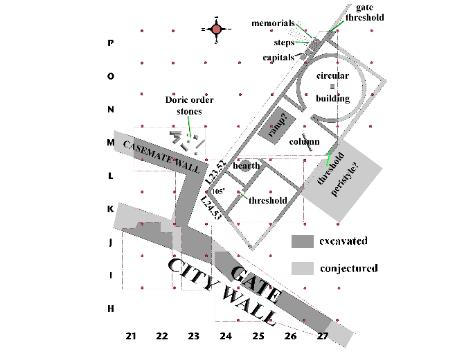The Paeonians
occupied the land north of ancient Macedonia and functioned as a
buffer zone with the Dardanians on their northern border. Bylazora, in fact, was
situated in a commanding position at the natural pass leading from Dardania
into Macedonia.
Philip V of Macedonia, who
ruled from 221 until 179 BC, captured Bylazora in 217 BC. By blocking the
Dardanian access road to Macedonia,
he freed his country from its repeated menacing raids. Perseus, Philip’s son,
who
succeeded his father, sent mercenaries to Bylazora to confront the Romans, but
he was defeated in 168 BC. He was taken to Rome
to be shown in their victory parade, together with the incredible wealth of Macedonia. The
rich kingdom became a mere Roman province.
Although Bylazora was the largest city of Paeonia
and was mentioned by Livy and Polybius, its location remained a
mystery. It was tentatively identified with (Titov) Veles, but the
results were inconclusive. As so often, the city was discovered by accident in
1994. Road works exposed a buried pool-like building close to modern Sveti Nikole in the Republic of North Macedonia,
some 50 kilometers
southeast of Skopje,
between the Axios and the Strymon
Rivers.
Excavations
started in 2008 after the Museum of Sveti Nikole invited the Texas
Foundation for Archaeological & Historical Research (TFAHR) to a joint cooperation.
It was a slow
process of searching for clues that started at the top of the hill, the
Acropolis. Soon, a section of the northern defensive wall was exposed, followed
by the discovery of a ramp leading up to the Propylon. Next, a Stoa with Doric
columns was identified and dated to the days of Philip V based on a similar gallery built by Attalus II in Athens.
A long wall and
successive rooms were unearthed, making the archaeologists realize they had
found the Palace of Philip V and
Perseus, the last two kings of Macedonia.
The first room
they explored had all the characteristics of a kitchen, with a fireplace, much
pottery, plates, vessels, and amphorae from the 3rd-2nd century
BC. The walls were covered with a thick layer of plaster with traces of paint.
Followed a room with columns and capitals, which was named Ante-room since it
connected to a more important Tholos. For those who visited the Palace of Aegae in Greece,
that space is very recognizable. On the other side of this Tholos lies the
Entrance Hall, which in turn is connected to the Vestibule. This large room
opened onto the Outer Courtyard via a monumental staircase.
Keeping the
layout of the Palace
of Aegae in
mind, the archaeologists projected the same series of rooms around the Inner Courtyard.
The picture seems to fit perfectly. It also matches the Palace
of Dimitrias, situated
just south of Volos
in Greece.
The city was built by Demetrios Poliorcetes
when he was king of Macedonia,
i.e., 294-288 BC.
Until now, and as
opposed to Aegae and Pella,
I had no knowledge of the Macedonian Palaces of Bylazora or Dimitrias.
The destruction of the Palaces of Aegae and Pella by the Romans is well-documented.
Dimitrias,
however, was entirely dismantled, and it is assumed that the same happened in Bylazora,
although it was never finished.
Much more
pertinent information with clear maps and unique details can be found in this lecture given by Dr.
William J. Neidinger of the TFAHR.
[Pictures from TFAHR]



No comments:
Post a Comment